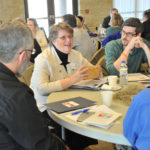
Father Paul Appel, pastor of Jesus Christ, Prince of Peace Parish-Clinton, presides at Mass near the shores of the Sea of Galilee at the Mount of Beatitudes where Jesus said, “Feed my lambs, feed my sheep.” Concelebrating is Father Ben Snyder, parochial vicar at Our Lady of Lourdes Parish-Bettendorf. The two priests and a group of pilgrims returned from the Holy Land last week.
By Anne Marie Amacher
The Catholic Messenger
Two diocesan priests and the 26 people who participated with them on a pilgrimage to the Holy Land arrived home safely after war broke out between the militant group Hamas and Israeli forces. Hamas attacked southern Israel near the Gaza Strip on Oct. 7. Israel declared war the following day, which was midway through the diocesan group’s pilgrimage.
The pilgrims began their visit in Jordan, then visited Mount Nebo, Petra and the Dead Sea. They also visited the Sea of Galilee and were in Nazareth when the fighting broke out, said Father Ben Snyder, parochial vicar of Our Lady of Lourdes Parish in Bettendorf. He and Father Paul Appel, pastor of Jesus Christ, Prince of Peace Parish in Clinton, were the spiritual leaders on the pilgrimage.
“The trip really began to feel like a pilgrimage at this point (the day of the surprise attack) because we were seeing the places mentioned in the Scripture,” Father Appel said in his parish bulletin last week. “That evening we began to receive reports that Hamas had attacked civilians in southern Israel and things began to change. As we tried to get some sleep in our Nazareth hotel, we could hear airplanes flying overhead and rumbles off in the distance. In the morning I believe that most people in the country thought the conflict would be over soon.”
Father Appel said the scope of the massacre made clear that the violence would not end soon. The pilgrimage was far from the fighting so the pilgrims “continued to see some of the sites on our itinerary.” Air raid sirens did not go off until “we were at an overlook of Jerusalem,” Father Snyder said. “We were outside and got back into the bus. We heard five shots of the Iron Dome (air defense system), but that was it. There were no other air raid sirens or rockets that came anywhere near Jerusalem while we were there.”
The group visited the Church of the Nativity, Gethsemane, the Church of the Assumption, Via Dolorosa (Way of the Cross), and the Holy Sepulcher in Old Jerusalem and Church of the Ascension from a distance, Father Snyder said. The Western Wall excursion was cancelled. The guide “gave us a historical and geographical presentation on Old Jerusalem and a history of the conflicts since the time of Jesus to the formation of the modern state of Israel to today. We also did a rosary together as a group and did the readings for the sites we weren’t able to visit since we weren’t able to have Mass either.”
“For the most part it seemed like business as usual. It was tense for sure and we heard there was more security in certain places, but we didn’t see any of it,” Father Snyder said. “The closest we came was when we were leaving Bethlehem. We were rerouted to one checkpoint since most of the others were closed.” As the week progressed, “our guides were concerned about our security but from hearing about trips my seminary classmates have gone on over the years, this is common for areas to be unsafe due to clashes with security.”
Father Appel hoped “matters would improve,” but they did not. On Oct. 10, after a visit to the Church of the Holy Sepulcher, 18 pilgrims shortened their stay and headed to Amman, Jordan to catch flights back home. Those who remained in Jerusalem headed to Jordan on Oct. 12, a day earlier than the pilgrimage was to end. “Friday the 13th was the day the leaders of Hamas called for a ‘day of vengeance,’” so the guides opted to head to Jordan a day early, Father Snyder said. “It was a good call because Israel closed the border with Jordan late Thursday afternoon through Friday.” The group had tickets to leave from Tel-Aviv but because of the ongoing fighting, pilgrims caught different flights in Jordan to return home.
Despite what happened, Father Snyder especially appreciated seeing Galilee and the Church of the Nativity. “Galilee is a beautiful area and it gives perspective on distance and the stories in the Bible. An example is that Jesus lived in Capernaum and you can see the Mount of Beatitudes from the ruins of the village. The Sea of Galilee itself is not big, so all the major towns Jesus mentions can be seen from the lake. The Mount of Beatitudes is a beautiful view of the sea and it’s easy to visualize the Bible scenes.”
Because of the war, fewer people were visiting the Church of the Nativity so the diocesan group had more time to spend there, Father Snyder said. The conflict played a part of the trip, as well, he said. It made the psalms in the Liturgy of the Hours more meaningful for him. “It was a reminder that the time of Jesus was not peaceful either. It was a time of Roman occupation, Zealot movements, revolutions, districts, which are all similar to today.”
Both priests thanked the faithful for their prayers while the pilgrims were in Israel.











